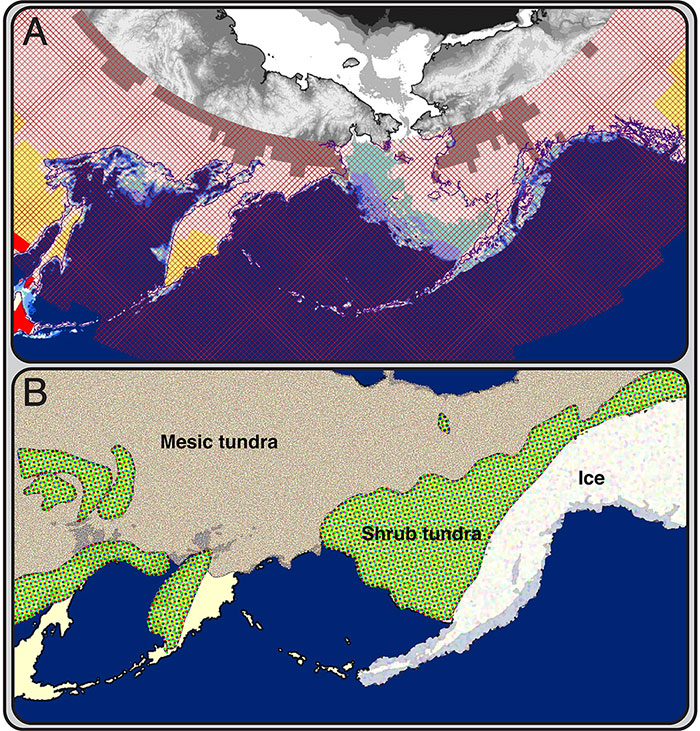Genetic analysis suggests mothers in Ancient Beringia transferred elevated levels of critical nutrients via breast milk

LAWRENCE — As scientists have studied how ancient populations migrated into the Americas, they have often wrestled with the question of how people survived in harsh climates in the Arctic where a dearth of sunlight makes it difficult for the body to get vital nutrients.
Recent genetic analysis suggests that during the Last Glacial Maximum ice age, in the harsh Beringian Landmass, mothers transferred elevated levels of critical nutrients, particularly vitamin D and fatty acids, to infants via breast milk, according to a new study that includes a University of Kansas anthropologist.
The study posits one of the first examples of selection on the maternal-infant nursing relationship in humans, and it draws attention to how critical that relationship has been and continues to be for human survival across a range of environments. As modern humans expanded across continents, especially from Asia into the Americas, some populations moved into extreme environments with frigid temperatures and little sunlight — a key source of vitamin D — that intensified selection on existing genomic variation.
 The Proceedings of the National Academy of Sciences, or PNAS, published the research group's findings Monday afternoon. Leslea Hlusko, associate professor of integrative biology at the University of California-Berkeley, is the corresponding author. Dennis O'Rourke, a KU Foundation Distinguished Professor of Anthropology, is a co-author and can speak particularly about the population genetics involved in the study.
The Proceedings of the National Academy of Sciences, or PNAS, published the research group's findings Monday afternoon. Leslea Hlusko, associate professor of integrative biology at the University of California-Berkeley, is the corresponding author. Dennis O'Rourke, a KU Foundation Distinguished Professor of Anthropology, is a co-author and can speak particularly about the population genetics involved in the study.
"It provides a strong biological foundation for how and why selection may have acted on this particular variant, based on the unique environmental context of long residence in the Arctic region," said O'Rourke, who also directs the KU ancient DNA Laboratory and is associate director of the Laboratories of Biological Anthropology. "We already know that selection acted on populations living at higher latitudes via vitamin D availability, and this variant, and its pleiotropic effects, are additional evidence of this."
The selected allele of the human-specific ectodysplasin A receptor gene, or EDAR, has a range of effects, including sweat gland density, incisor shoveling and mammary ductal branching.
The researchers were able to identify the frequency of the EDAR V370A variant as elevated in North and East Asian as well as the New World populations due to a bout of positive selection that occurred about 20,000 years ago. Their hypothesis is that selection on this allele occurred in the Beringian refugium population because it allowed for increases in mammary ductal branching, amplifying the transfer of critical nutrients in the vitamin D-deficient conditions to infants via mother's milk.
Previous hypotheses had focused on the concept that the near fixation of this allele was caused by selection for modulation of thermoregulatory sweating.
"We linked the pleiotropic effects known in the literature with dental variants that are nearly unique to Native American and some Siberian groups, along with the variant's role in breast physiology that affects nutrient transfer from mother to infant, to make the case for selection in an isolated Beringian population," O'Rourke said.
The Beringian standstill population existed for a relatively brief time of perhaps a few thousands of years, the researchers said, before it dispersed and merged with populations from elsewhere in Asia or expanding into new territories in the Americas.
"Our focus was to demonstrate that the geographic distribution of this variant, EDAR V370A, and the likely selection on it in Arctic environments, provides additional evidence for a resident population in Beringia during the last glacial maximum," O'Rourke said.
The findings are significant in examining how the Western Hemisphere was populated and migration occurred, he said, and the level of analysis the group used regarding genomics can be key in future research.
"We can now focus on such adaptive variants in our new lab, and it provides some new directions for researchers in the lab to pursue," O'Rourke said. "Identifying signals of natural selection in ancient DNA is something we have begun to work on, and this should spur work in that area."
Image: Illustration of geography of the Beringian Landmass, where people migrated into the Americas roughly 20,000 years ago. In a new study that includes a University of Kansas anthropologist, researchers found mothers transferred elevated levels of critical nutrients, particularly vitamin D and fatty acids, to infants via breast milk, which was essential for survival in the harsh climate. Credit: Proceedings of the National Academy of Sciences